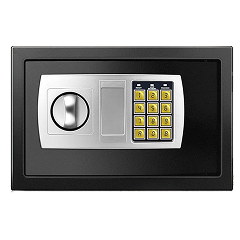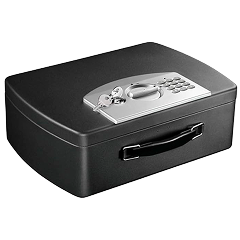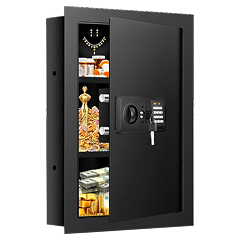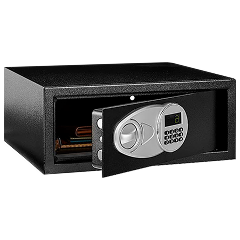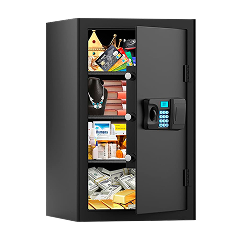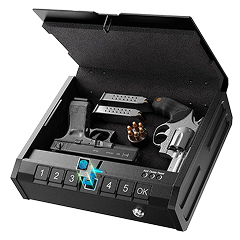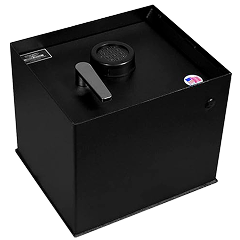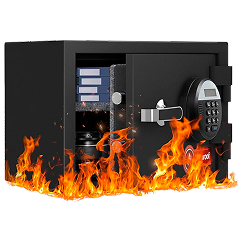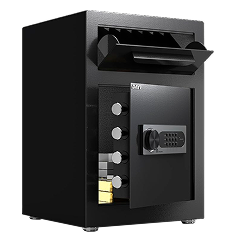When I bought my first firearm, I thought a gun safe was optional. Wrong. Break-ins on the other side of town and stories about kids finding loaded guns changed my perspective fast. A gun safe does two jobs at once: it keeps unauthorized hands away from your firearms and protects them from house fires that can cook off ammunition.
As an engineer, I’m used to looking at spec sheets, so I skip the marketing nonsense and look at what actually works. After buying two safes, a dial combination model and a keyed fire safe, I’ve figured out the real differences between protecting guns versus documents. Rifles take up way more space than you’d think, and ammunition storage has completely different fire safety requirements.
Gun Safe Security Ratings Explained
After researching security standards for safe purchases, I discovered that gun safes need legitimate third-party certifications rather than manufacturer marketing claims. UL’s RSC rating sets the floor for gun safes.
Your safe needs to survive at least five minutes of attacks using everyday tools like crowbars and hammers. California’s Department of Justice pushes things further with construction standards designed specifically for firearm storage.
Want real security? Skip basic RSC and go for UL TL-15 or TL-30 certifications. These test safes against professional burglary tools like cutting torches and diamond-tipped drills. A TL-15 rating means professional thieves with serious equipment couldn’t crack it in 15 minutes of focused attack.
Key security ratings you should know:
- No Rating – Avoid these completely for firearms
- UL RSC – Minimum acceptable standard for gun safes
- California DOJ Approved – Meets state firearm storage requirements
- UL TL-15/TL-30 – Professional-grade protection against advanced attacks
Choosing the Right Size and Capacity
Here’s the dirty secret: gun safe capacity numbers often don’t match real situations. Manufacturers test with bare rifles, no scopes, no accessories, packed like sardines. That “20-gun safe” you’re eyeing? Plan on 12-15 rifles with real-world gear. Some buyers learned this the hard way with their first purchases.
The walls eat up tons of space. My 80-pound safe looks decent from the outside, but the steel and insulation make the inside cramped. You need room for ammo boxes, cleaning gear, and paperwork, too. Rifles are long, handguns need different shelving, and you’ll want adjustable everything because your collection will change.
Locking Mechanisms: Dial, Digital, and Biometric
Speed versus reliability—pick one because you can’t have both.
Mechanical Dial Locks
My combination safe has a traditional dial that’s worked flawlessly for three years without any fuss. No batteries to die, no electronics to fail during thunderstorms. Dial locks work during power outages and after months of neglect. The catch? Opening takes 30 seconds of careful dialing, which is not great for emergency access. Cheap dials develop slop over time, making the combination harder to hit consistently.
Digital Keypads
Digital locks offer faster access than dial combinations, typically opening in 5-10 seconds once you’ve memorized your code. Most include backup key override and low-battery warnings, though I’ve read about failures during humid conditions or after battery leaks.
Battery life varies wildly between manufacturers. Some last for a few years while others need replacement every few months. The main advantage is programmable codes that you can change easily, plus some models allow multiple user codes.
Biometric Scanners
While I don’t own a biometric safe, I find that they’re hit-or-miss for reliability. Fingerprint readers can fail due to cuts, calluses, or dirty fingers, exactly when you might need quick access most.
They work best as secondary locks combined with keypads rather than primary security. The technology has improved, but I’d still want a backup access method given the potential for false rejections during emergencies.
Fire Protection Levels for Gun Safes
Ammunition changes everything about fire protection. While paper documents burn at 1,700°F, ammo starts cooking off around 400°F, which is hot enough to punch holes through thin safe walls.
The small fire safe protects documents well, but gun safes need specialized ratings that account for both firearm preservation and ammunition safety. The tradeoff is real: Thicker fire insulation means less interior space, so you’ll pay more for both the protection and the lost storage capacity.
Fire rating considerations for gun safes:
- 30-60 minutes – Basic protection for most home fires
- 90-120 minutes – Better coverage for larger homes or slower fire response
- Temperature limits – Look for ratings under 350°F internal temperature
- Ammunition storage – Keep ammo in separate compartments when possible
- Insulation tradeoffs – More fire protection means thicker walls and less interior space
Evaluating Construction Quality
Steel thickness makes the difference between a security container and a pry-bar victim. Gun safes should use 7-gauge steel or thicker for the body; anything thinner can be cut with standard tools in minutes. My 80-pound safe uses thick steel that gives it that solid, substantial feel when you rap your knuckles against it.
Doors need extra attention since thieves focus their attacks there. Look for doors at least 3 inches thick backed by serious locking hardware.
Bolt count and placement tell you how well a safe resists prying. Cheap safes skimp with 3-6 bolts clustered on one side, while serious models use 12 or more bolts reaching into all four sides of the frame. I learned this by examining my combination safe. You can watch the bolts engage when you work the handle. More bolts spread the load if someone tries to pry the door, making a breakthrough much tougher.
Hinge design and door fit reveal manufacturing standards that aren’t obvious from specification sheets. External hinges are easier to attack than internal ones, though they do allow wider door opening for access.
When I close my safe, there’s a minimal gap around the door frame. If there are sloppy tolerances, it could indicate poor construction throughout. Weight alone doesn’t guarantee excellence, but a well-built gun safe will feel dense and solid due to the thick steel and concrete fill used in better models.
Mounting and Anchoring Your Gun Safe
Unbolted safes are just heavy toolboxes waiting for thieves with trucks. My research on home invasion shows that burglars love to grab small safes and crack them later with shop tools and unlimited time. Most gun safes have pre-drilled holes for half-inch bolts or concrete anchors. The location you choose to bolt it down can be tricky. You want it secure but accessible, which means avoiding tight corners where you can’t swing the door open.
Professional Installation vs. DIY
Pros bring the right tools, know building codes, and warranty their anchoring work. Expect to pay $200-500, depending on safe weight and installation complexity. DIY works fine for smaller safes if you own a hammer drill and understand your floor construction.
Concrete is straightforward; wood floors over basements need careful joist placement. I tackled my smaller safe with concrete anchors and a borrowed drill, but monster gun safes over 300 pounds really benefit from professional delivery teams.
Interior Customization Options
Basic foam shelves won’t cut it for long. Your gun collection may outgrow whatever generic setup comes standard. Rifles vary wildly in length; an AR with a folding stock versus a full-size hunting rifle needs totally different rack spacing. Door panels with pistol holsters help maximize storage, and barrel rests prevent guns from scratching each other.
Electrical accessories like LED lighting and dehumidifiers add convenience but create dependency on power sources. Interior lighting helps tremendously when you want to grab specific firearms quickly. However, battery-powered options avoid the hassle of running electrical lines.
Dehumidification prevents rust in humid climates, but simple desiccant packs work nearly as well without adding electricity to the safe. Focus on organization systems first—you can always add electrical features later, but you can’t easily change a safe’s interior layout after purchase.
Avoiding Common Gun Safe Pitfalls
I’ve made most of these mistakes myself, and they’re expensive to fix after the fact.
- Buying too small – Collections grow fast, and manufacturer gun capacity ratings often claim more guns can fit than you actually can.
- Skipping fire protection – House fires melt guns and explode ammo.
- Ignoring anchor points – Thieves love portable safes that they can walk away with and crack at home.
- Choosing cheap locks – Nothing worse than being locked out of your own guns.
- Overlooking interior layout – Fixed shelving wastes space and money.
- Forgetting about access speed – Practice opening until it’s muscle memory.
Getting the Best Value for Your Budget
You get what you pay for with gun safes, but the price jumps aren’t always worth it. Safes under $1,000 work for basic storage but skimp on fire protection and locks. The $1,000-3,000 range hits the sweet spot for most people and has real UL ratings and decent fire resistance. Above $3,000, you’re paying for serious security that can stop professional thieves.
Choosing the Right Gun Safe for Your Needs
Figure out what you actually need before you get distracted by features. Count your guns, add half for future purchases, then account for ammo and accessories. UL ratings matter more than brand names, and steel thickness beats marketing copy every time. From my engineering background means I trust numbers over sales pitches, and three years of safe ownership proves that build quality pays off daily.
The best gun safe is one you’ll actually use consistently. Quick access for home defense? Prioritize reliable electronic locks over maximum security ratings. Protecting a valuable collection? Spring for higher ratings and professional installation. A medium-priced safe that you bolt down and use often regularly beats an expensive paperweight sitting loose in the garage. Test the locks in person before you buy one. Spending ten minutes at the store saves years of frustration later.


